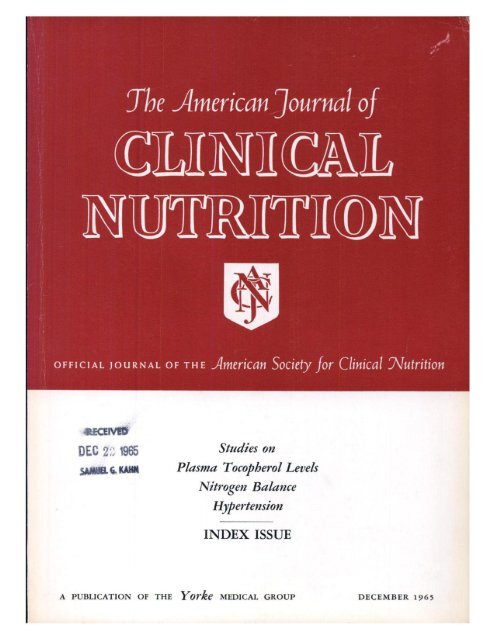一项多地点、以社区为基础的病例对照研究,旨在检查有或没有发育迟缓和其他疾病的幼儿的营养摄入是否充足:来自探索早期发育研究(SEED)的发现。
IF 6.5
1区 医学
Q1 NUTRITION & DIETETICS
引用次数: 0
摘要
背景:人们对发育障碍儿童的饮食表达了频繁的关注。然而,以前的报告都是基于小样本。目的:本研究旨在评估自闭症谱系障碍(ASD)、其他发育迟缓和障碍(DD)儿童和普通人群对照(POP)儿童的营养摄入量,并检查营养摄入量是否充足。设计:探索早期发展研究(SEED)是一项多地点、基于社区的病例对照研究,旨在更好地了解ASD。儿童(2 - 5岁)的父母完成了为期3天的饮食日记,记录他们的孩子摄入的所有食物和饮料(不包括膳食补充剂)。对日记食物进行宏量和微量营养素含量分析。方差分析分析了三组儿童营养摄入的差异(结果标准:饮食记录(n=1227): ASD (n=338), DD (n=412)和POP (n=477)。在儿童的营养摄入量方面,几乎没有临床意义上的组间差异,大多数人达到了ear,而很少有人的摄入量高于ul。值得注意的例外包括:1) 10%的儿童维生素A和E、泛酸盐、钙和纤维摄入量低于EAR;2)烟酸、叶酸、锰和添加糖的含量高于最低标准值10%;3) >80%的添加糖高于UL, >95%的添加纤维不符合EAR。结论:可以从这项研究中得到保证,幼儿从食物中摄取的营养,包括那些有发育障碍的儿童,符合大多数营养充足的建议。有必要进一步研究食物摄入模式和饮食质量,并同时研究营养状况的临床指标。本文章由计算机程序翻译,如有差异,请以英文原文为准。
A multisite community-based, case-control study to examine the nutrient intake adequacy of young children with and without developmental delays and other disorders: findings from the Study to Explore Early Development (SEED)
Background
Frequent concerns are expressed about the diets of children with developmental disabilities. However, previous reports have been based on small samples.
Objectives
The study aimed to assess nutrient intakes of young children with autism spectrum disorder (ASD), children with other developmental delays and disorders (DD), and general population controls (POP) and to examine nutrient intakes for adequacy.
Methods
The Study to Explore Early Development is a multisite community-based, case-control study designed to understand ASD better. Parents of children (aged 2–5 y) completed 3-d diet diaries to capture all foods and beverages (excluding dietary supplements) consumed by their children. Foods from diaries were analyzed for macronutrient and micronutrient content. Analysis of variances examined group differences in nutrient intakes (criterion of P < 0.001). Chi-square tests of independence examined differences in the proportion of children in each group: 1) not meeting the estimated average requirements (EAR) and 2) exceeding the tolerable upper intake level (UL) for each nutrient, with the examination of standardized residuals (= ±1.96) to ascertain differences among groups.
Results
Diet records (n = 1227) were obtained for children in the 3 groups: ASD (n = 338), DD (n = 412), and POP (n = 477). Few clinically important group differences were noted in children’s nutrient intakes and most met EARs although few had intakes above the ULs. Notable exceptions included: 1) >10% of children below the EAR for vitamins A and E, pantothenate, calcium, and fiber; 2) >10% above the ULs for niacin, folate, manganese, and added sugars; 3) >80% were above the UL for added sugars and >95% did not meet EAR for fiber.
Conclusions
Reassurance can be taken from this study that young children’s nutrient intakes from food, including those with developmental disabilities, meet most recommendations for nutrient adequacy. Further study of food intake patterns and diet quality is warranted, with concurrent clinical indicators of nutrient status.
求助全文
通过发布文献求助,成功后即可免费获取论文全文。
去求助
来源期刊
CiteScore
12.40
自引率
4.20%
发文量
332
审稿时长
38 days
期刊介绍:
American Journal of Clinical Nutrition is recognized as the most highly rated peer-reviewed, primary research journal in nutrition and dietetics.It focuses on publishing the latest research on various topics in nutrition, including but not limited to obesity, vitamins and minerals, nutrition and disease, and energy metabolism.
Purpose:
The purpose of AJCN is to:
Publish original research studies relevant to human and clinical nutrition.
Consider well-controlled clinical studies describing scientific mechanisms, efficacy, and safety of dietary interventions in the context of disease prevention or health benefits.
Encourage public health and epidemiologic studies relevant to human nutrition.
Promote innovative investigations of nutritional questions employing epigenetic, genomic, proteomic, and metabolomic approaches.
Include solicited editorials, book reviews, solicited or unsolicited review articles, invited controversy position papers, and letters to the Editor related to prior AJCN articles.
Peer Review Process:
All submitted material with scientific content undergoes peer review by the Editors or their designees before acceptance for publication.

 求助内容:
求助内容: 应助结果提醒方式:
应助结果提醒方式:


